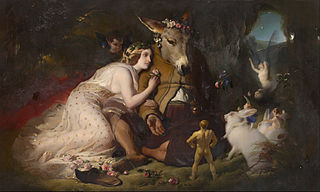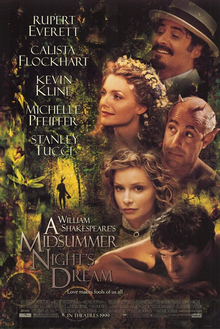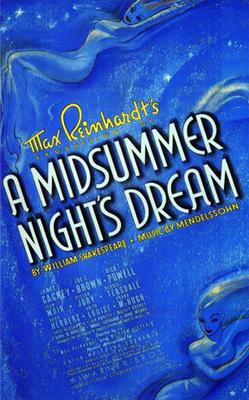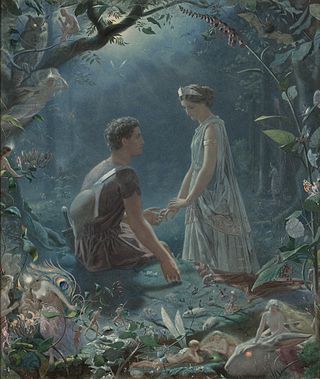
A Midsummer Night's Dream is a comedy written by William Shakespeare in about 1595 or 1596. The play is set in Athens, and consists of several subplots that revolve around the marriage of Theseus and Hippolyta. One subplot involves a conflict among four Athenian lovers. Another follows a group of six amateur actors rehearsing the play which they are to perform before the wedding. Both groups find themselves in a forest inhabited by fairies who manipulate the humans and are engaged in their own domestic intrigue. The play is one of Shakespeare's most popular and is widely performed.

Puck, or Robin Goodfellow, is a character in William Shakespeare's play, A Midsummer Night's Dream.

Oberon is a king of the fairies in medieval and Renaissance literature. He is best known as a character in William Shakespeare's play A Midsummer Night's Dream, in which he is King of the Fairies and spouse of Titania, Queen of the Fairies.

The mechanicals are six characters in A Midsummer Night's Dream who perform the play-within-a-play Pyramus and Thisbe. They are a group of amateur and mostly incompetent actors from around Athens, looking to make names for themselves by having their production chosen among several acts as the courtly entertainment for the royal wedding party of Theseus and Hippolyta. The servant-spirit Puck describes them as "rude mechanicals" in Act III, Scene 2 of the play, in reference to their occupations as skilled manual laborers.
Fairy painting is a genre of painting and illustration featuring fairies and fairy tale settings, often with extreme attention to detail. The genre is most closely associated with Victorian painting in the United Kingdom, but has experienced a contemporary revival. Moreover, fairy painting was also seen as escapism for Victorians.

Nick Bottom is a character in Shakespeare's A Midsummer Night's Dream who provides comic relief throughout the play. A weaver by trade, he is famously known for getting his head transformed into that of a donkey by the elusive Puck. Bottom and Puck are the only two characters who converse with and progress the three central stories in the whole play. Puck is first introduced in the fairies' story and creates the drama of the lovers' story by messing up who loves whom, and places the donkey head on Bottom's in his story. Similarly, Bottom is performing in a play in his story intending it to be presented in the lovers' story, as well as interacting with Titania in the fairies' story.

Snug is a minor character from William Shakespeare's play A Midsummer Night's Dream. He is a joiner who comes from Athens who is hired by Peter Quince to play the part of the lion in Pyramus and Thisbe. When he is first assigned the part, he is afraid it may take him a while to finally remember his lines. Bottom offers to play the part of the lion, but he is rejected by Quince, who worries that his loud and ferocious roar in the play will frighten the ladies of power in the audience and get Quince and all his actors hanged. In the end, the lion's part is revised to explain that he is in fact not a lion and means the audience no harm.

Titania is a character in William Shakespeare's 1595–1596 play A Midsummer Night's Dream.

The Fairy-Queen is a semi-opera by Henry Purcell; a "Restoration spectacular". The libretto is an anonymous adaptation of William Shakespeare's comedy A Midsummer Night's Dream. First performed in 1692, The Fairy-Queen was composed three years before Purcell's death at the age of 35. Following his death, the score was lost and only rediscovered early in the twentieth century.

A Midsummer Night's Dream is a 1968 British film of William Shakespeare's play A Midsummer Night's Dream, directed by Peter Hall.

A Midsummer Night's Dream is a 1999 romantic comedy fantasy film based on the play of the same name by William Shakespeare. It was written, directed and co-produced by Michael Hoffman. The ensemble cast features Kevin Kline as Bottom, Michelle Pfeiffer and Rupert Everett as Titania and Oberon, Stanley Tucci as Puck, and Calista Flockhart, Anna Friel, Christian Bale, and Dominic West as the four lovers.

A Midsummer Night's Dream is a 1935 American romantic comedy fantasy film of William Shakespeare's play, directed by Max Reinhardt and William Dieterle, and starring James Cagney, Mickey Rooney, Olivia de Havilland, Jean Muir, Joe E. Brown, Dick Powell, Ross Alexander, Anita Louise, Victor Jory and Ian Hunter. Produced by Henry Blanke and Hal B. Wallis for Warner Brothers, and adapted by Charles Kenyon and Mary C. McCall Jr. from Reinhardt's Hollywood Bowl production of the previous year, the film is about the events surrounding the marriage of the Duke of Athens, Theseus, and the Queen of the Amazons, Hippolyta. These include the adventures of four young Athenian lovers and a group of six amateur actors, who are controlled and manipulated by the fairies who inhabit the forest in which most of the story is set. The play, which is categorized as a comedy, is one of Shakespeare's most popular works for the stage and is widely performed across the world. Felix Mendelssohn's music was extensively used, as re-orchestrated by Erich Wolfgang Korngold. The ballet sequences featuring the fairies were choreographed by Bronislava Nijinska.

A Midsummer Night's Dream is a 1909 American film directed by Charles Kent and J. Stuart Blackton, and starring Walter Ackerman and Charles Chapman. It was the first film adaptation of the eponymous play by William Shakespeare. The movie was made during summer 1909, but not released until December 25.
A Midsummer Night's Dream is a 1959 Czechoslovak animated puppet film directed by Jiří Trnka, his last feature length film before his death 10 years later in 1969. It is based on the Shakespeare play of the same name.

The 1970 Royal Shakespeare Company (RSC) production of A Midsummer Night's Dream was directed by Peter Brook, and is often known simply as Peter Brook'sDream. It opened in the Royal Shakespeare Theatre at Stratford-upon-Avon and then moved to the Aldwych Theatre in London's West End in 1971. It was taken on a world tour in 1972–1973. Brook's production of A Midsummer Night's Dream for the RSC is often described as one of the 20th century's most influential productions of Shakespeare, as it rejected many traditional ideas about the staging of classic drama.

John Simmons (1823–1876) was a British miniature painter and illustrator, known primarily for his watercolours of ethereal fairyland scenes, often illustrating Shakespearian or other literary works. He was one of several popular Victorian artists who together created "a genre of forest idyll" in their fairy paintings. They are often grouped with the Pre-Raphaelites. Simmons lived in Bristol, and also painted portraits. He was elected to membership of the Bristol Academy of the Fine Arts in 1849. He died in November 1876 and is buried at Arnos Vale Cemetery.

The Quarrel of Oberon and Titania is an oil on canvas painting by the Scottish artist Sir Joseph Noel Paton. Painted in 1849, it depicts the scene from William Shakespeare's comedy play A Midsummer Night's Dream, when the fairy queen Titania and fairy king Oberon quarrel; Oberon was considered the King of the fairies in medieval and Renaissance literature. When exhibited in Edinburgh during 1850, it was declared as the "painting of the season". It was acquired by the National Gallery of Scotland in 1897, having initially been bought by the Royal Association for Promoting the Fine Arts in Scotland during 1850. An earlier version of this painting was Paton's diploma picture, which was submitted to the Royal Scottish Academy in 1846; they paid £700 for it.

Hermia and Lysander is a watercolor painting created in 1870 by British illustrator and miniature portrait painter John Simmons. Based on a scene from Act II, scene II of William Shakespeare's comedy play A Midsummer Night's Dream, it measures 89 by 74 centimetres.

A Midsummer Night's Dream is a 2016 British television film based on the William Shakespeare play A Midsummer Night's Dream. It was adapted by Russell T Davies, directed by David Kerr and produced by Nikki Wilson. It stars Maxine Peake as Titania, Matt Lucas as Bottom, John Hannah as Theseus and Nonso Anozie as Oberon. The film was first broadcast on 30 May 2016 on BBC One.

Titania and Bottom is an oil painting by the Anglo-Swiss painter Henry Fuseli. It dates to around 1790 and is displayed at Tate Britain in London. It was commissioned for the Boydell Shakespeare Gallery and depicts a scene from A Midsummer Night's Dream by William Shakespeare.
















